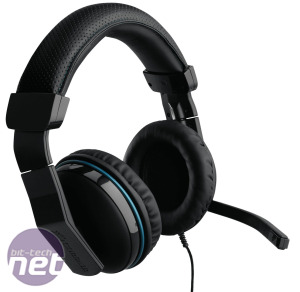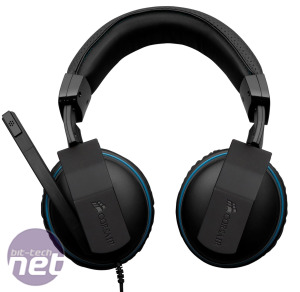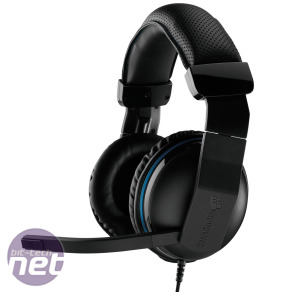
Corsair Vengeance 1300 Review
Manufacturer: CorsairUK price (as reviewed): £54.74 (inc VAT)
US price (as reviewed): $79.99 (ex tax)
Corsair has been making itself comfortable in the audio side of the PC market for a little while now. We saw its first headset, the HS1, all the way back in September 2010 - a release that was swiftly followed by the HS1A headset and the SP2500 and SP2200 2.1 speaker sets roughly a year ago. We’ve been largely impressed with what we’ve seen too, with all but the SP2200’s bagging a coveted bit-tech award (we don’t hand them out as regular as some, see).
A lot can happen in a year however and the HS1 and HS1A are starting to look a little long in the tooth, especially when compared to some of the new upstart entries into the market such as the Asus Vulcan ANC. We were pleased then when we heard that Corsair were planning to update their headset range to pull them in line with the Vengeance branding that its new mice and keyboards sport.
The model we’re looking at here is the Vengeance 1300, which is the cheaper of the two headsets and is based on the HS1A design. As with the HS1 and the HS1A though, the difference between the 1300 and its bigger brother, the 1500, are subtle. They’re so subtle in fact that you don’t seem to be losing out on much by opting for the 1300 - both it and the 1500 feature 50mm drivers, memory foam ear pads, a noise cancelling microphone and what Corsair call an optimized baffle and geometry that’s designed to funnel the sound waves into your ear canal with the minimum of fuss.
In fact the only substantive difference between the 1300 and the 1500 appears to be the former's lack of Dolby Headphone support - something which you may or may not find useful. Those of you who have invested in a competent sound card for example are likely to want to connect your headset to it, and this isn’t possible with the USB toting 1500.
Leaving the debate about which kind of connection offers the most flexibility aside for a bit, the 1300s are a good looking set of cans. Corsair seems to have learnt a lot from its previous pair of headsets, which looked dull compared to the competition. The blue streak around the closed back, circumaural ear cups of the 1300 adds an attractive dash of colour while the big flat arms of the headset are pleasingly rugged looking.
The headset is also very comfortable thanks to the padded headband and large ear cups. The 1300 actually has the beating of the Vulcan ANC here, as the thinner, more rectangular ear cups of the latter can cause problems for people with larger ears. Its sound quality that matters most with headsets however so we plugged the the 1300 and the Vulcan ANC into our X-Fi equipped test rig to see which would win in a straight shootout.
The honours were initially split, with both headsets providing plenty of punch and expression in both music and video. The fast, rolling, guitar and synth heavy music of 65daysofstatic sounded great on both sets, and acoustic or piano driven music also sounded good on both. We did notice that the Vulcan tended to pick out voice tones a little better than the 1300 however, though this wasn’t always desirable as sometimes it made the vocals feel slightly detached from the instruments behind them.
Gaming too proved to be a fairly even fight, with both sets sounding good when galloping across the frantic warzone that is Battlefield 3. Our one niggle is that, while Corsair have definitely boosted the bass on offer from the 1300 (compared to the HS1A on which its based) it still can’t quite match that offered by the Vulcan.
Corsair points out (rightly ) that this slight lack of bass oomph can be remedied by adjusting the EQ in your sound card’s control panel, but doing this is a hassle and could throw any other items that you plug into your soundcard, such as your speakers, out of kilter.
Volume also proved an area where the Vulcan won out. Yes the Corsairs have enough volume for everyday use but we all have occasions where we want to turn it up to 11, whether it’s because of the building site next door (STOP GODDAMN DRILLING!) or just because it’s been one of those days at work.
Conclusion
The Vengeance 1300 then is an extremely competent headset - it certainly improves on the HS1A that it replaces in many areas, most notably aesthetics and in terms of pure bass power. It’s not quite a big enough leap though, as the Vulcan really raised the bar of what we expect from a top end headset, pushing everything else down the pecking order as it did it.We're in the bizarre situation then whereby we're giving the 1300 a worse score than the HS1A that it replaces, despite saying it's a better headset only a couple of sentences ago. Changing goalposts are a feature of the tech industry however, so this shouldn't take away from the fact that if you don't think you'll use the noise cancelling feature of the Vulcan set, the 1300 is a solid purchase.

-
Sound Quality34 / 40
-
Design26 / 30
-
Value24 / 30


MSI MPG Velox 100R Chassis Review
October 14 2021 | 15:04












Want to comment? Please log in.